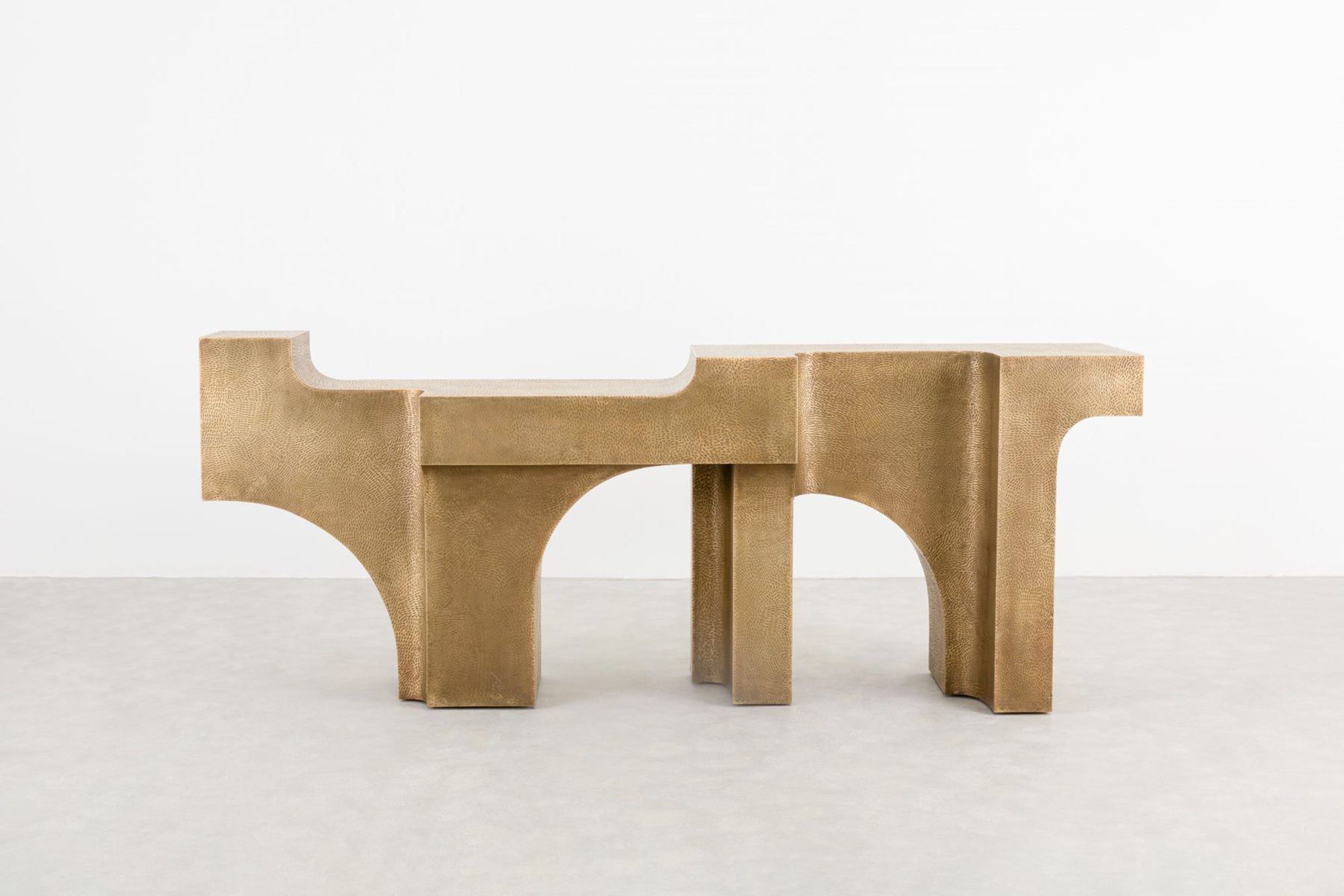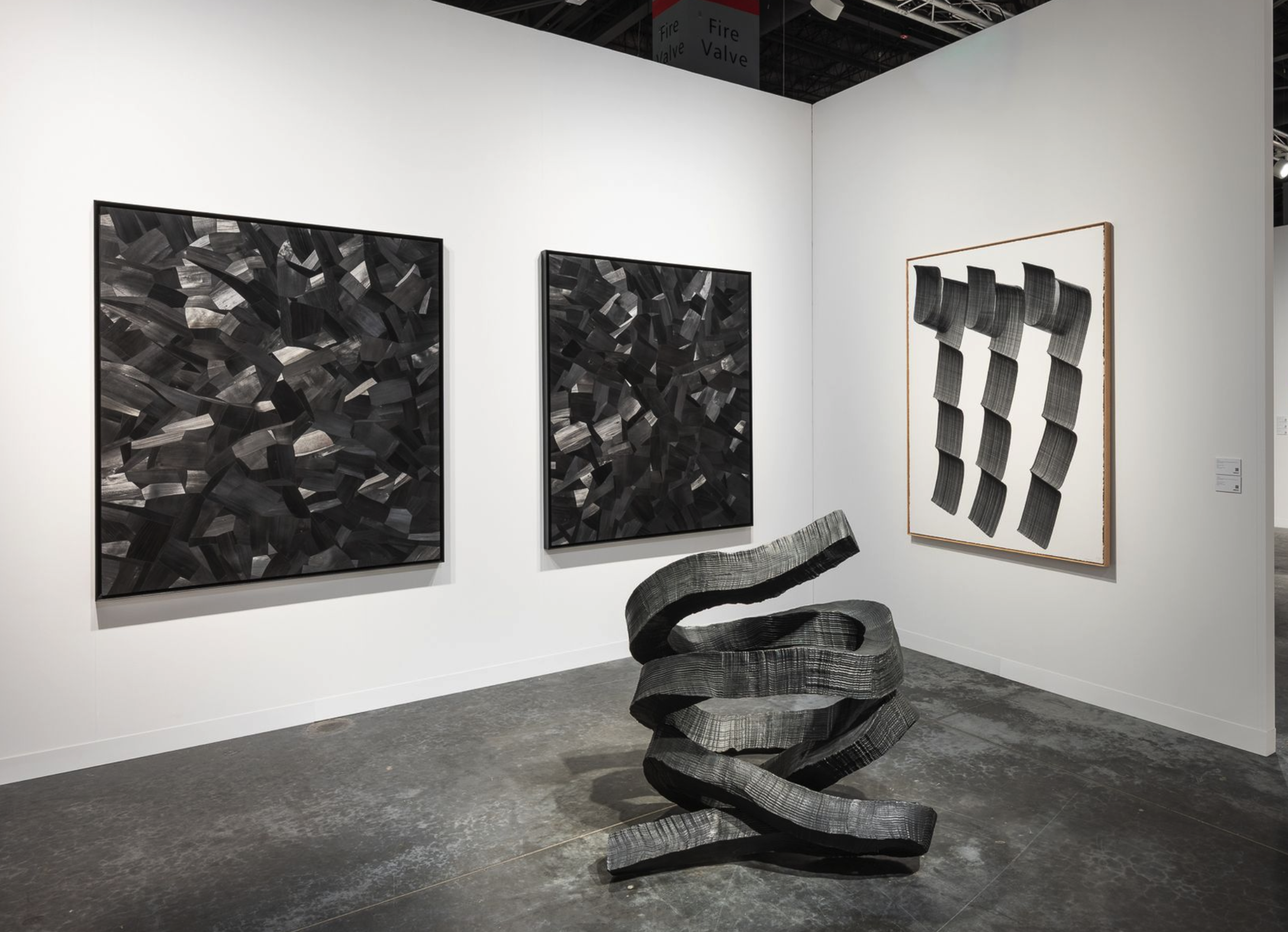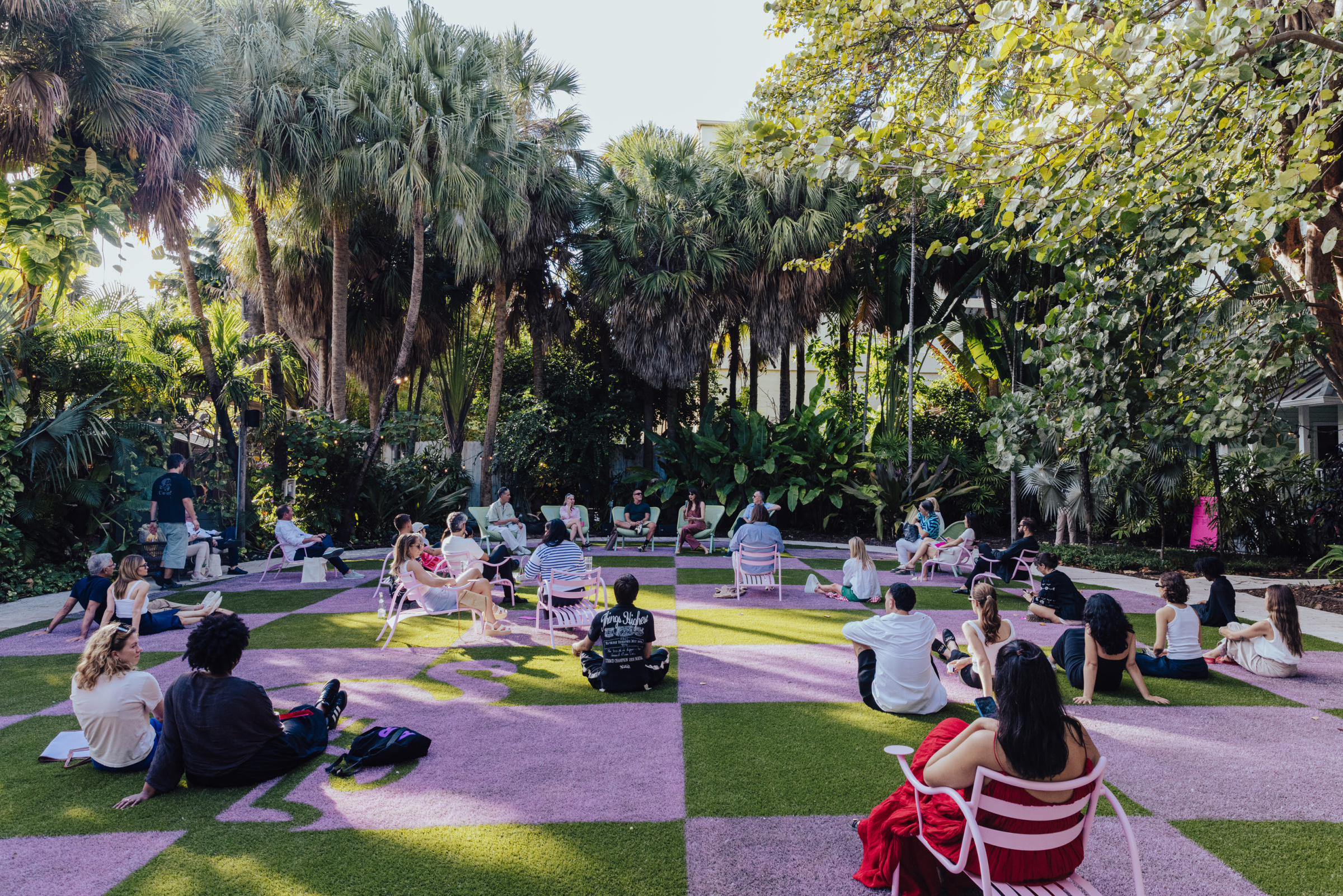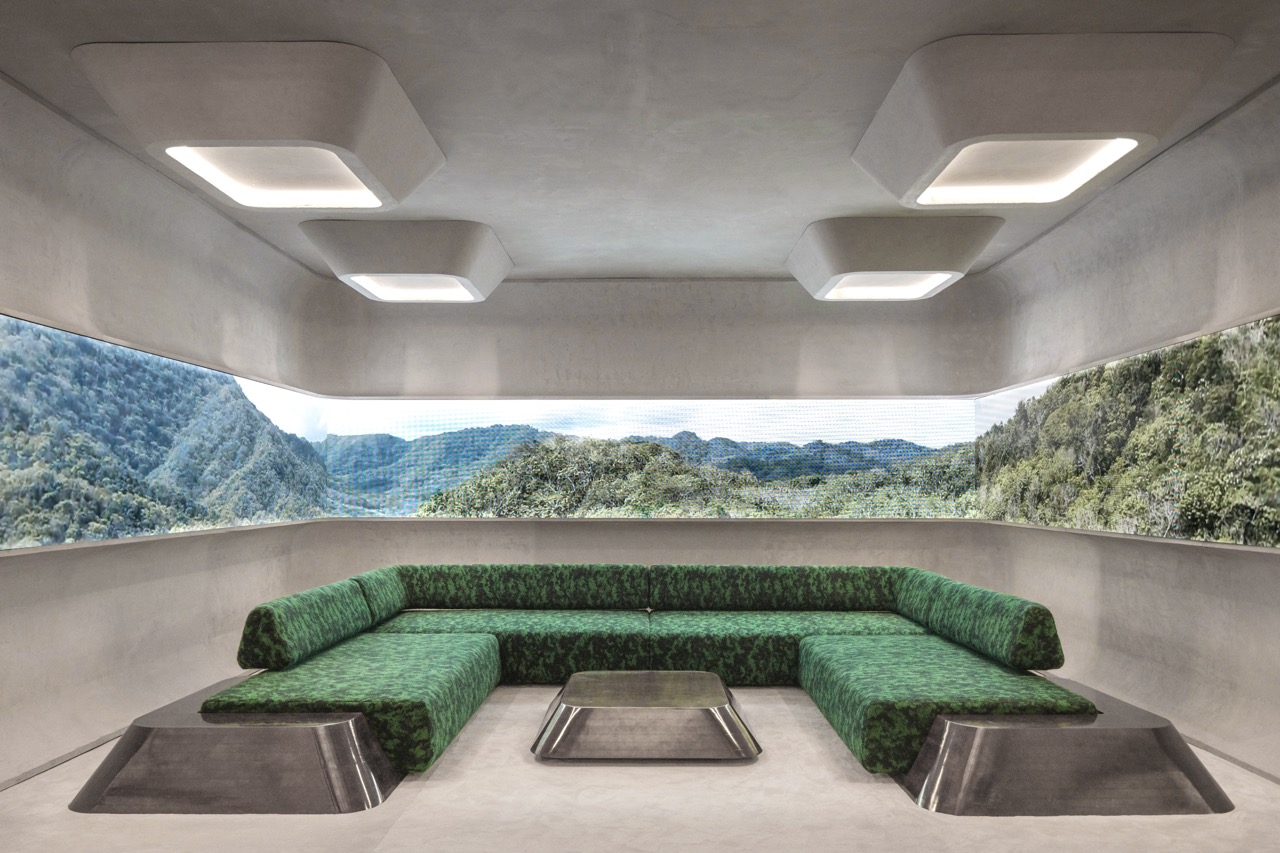From October 10 – 15, the chic PAD Design + Art Fair returns to London for its 15th year. The fair, which also takes over Paris each April, is the only fair in the United Kingdom that exclusively spotlights 20th century and contemporary design. Founder Patrick Perrin, who comes from a long lineage of Parisian antique dealers, channels his curatorial vision and eclectic taste to bring the world’s leading designers to London’s Berkeley Square, surrounding the old monied gardens with the most daring trends in design.
In honor of 15 years of PAD London, we’ve rounded up our 15 favorites from this year’s gathering. With more than 60 participating galleries, including those specializing in ceramics and collectible jewelry, it was tricky to narrow down what impressed us most. Make sure to explore the PAD London exhibitors to add your own picks to our list.
1. Lose Control Table by Mircea Anghel
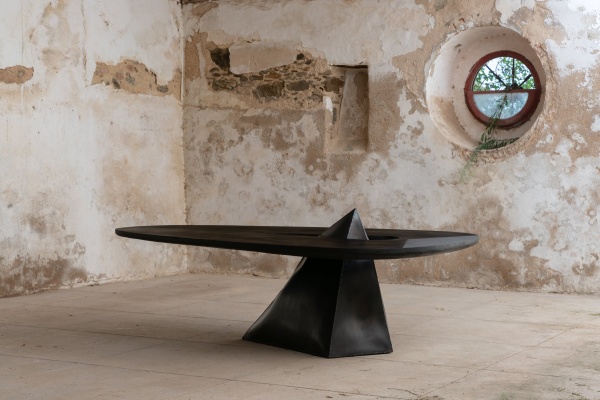
Lose Control Table by self-taught designer Mircea Anghel. Photo by Richard John Seymour, courtesy of Mircea Anghel and Objects With Narratives.
Self-taught designer Mircea Anghel is the founder of Cabana Studio in Portugal. Inspired by boat builders along the coast, Mircea left a career in finance to study woodworking and furniture design. He incorporates natural elements like wood, stone, and salt into his precarious, levitating tables.
Objects With Narratives brings us Mircea’s Lose Control Table, an abstracted fulcrum that spears through its lever to create a gravity-defying surface. The oblong burned Zazange wooden plane looks like it should bob up and down, but the thick, prismatic, exploded metal base keeps the materials suspended in air.
2. Cooper Roots by JAMESPLUMB
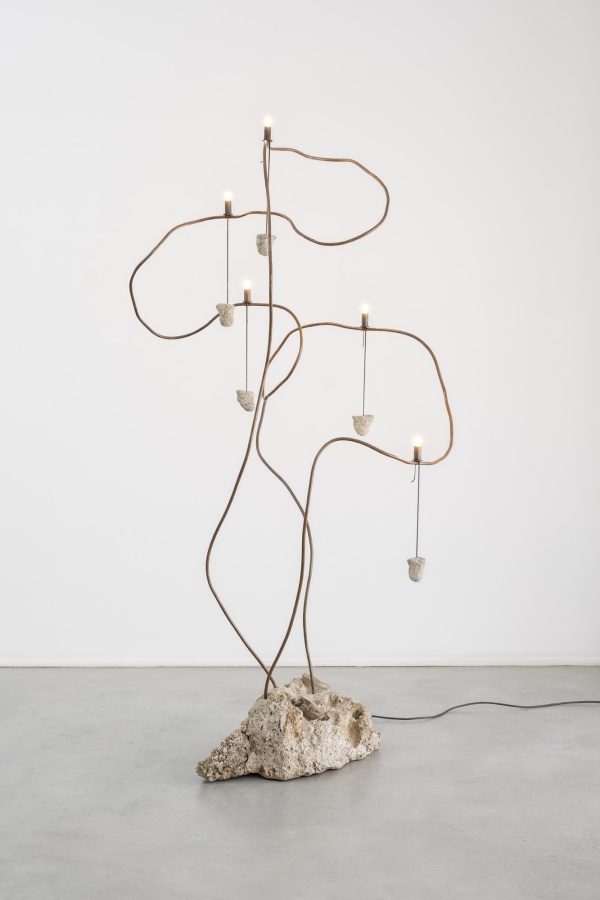
Cooper Roots is a candelabra made from brass stone by JAMESPLUMB. Courtesy of Gallery FUMI
JAMESPLUMB is actually two artists: Hannah Plumb and James Russell. The two love working with thin, winding, organic shapes, so delicate that they look like curling wisps of smoke on the verge of dissipating. JAMESPLUMB captures the essence of those temporary forms with brass, steel, and stone.
Copper Roots is a one-of-a-kind standing candelabra. The brass conduits burst from a rugged block of limecrete, bending like willow branches. The bespoke lamps cannot be mass produced, and every piece shown at Gallery FUMI is different.
3. Volumetric Chair 7 by Voukenas Petrides
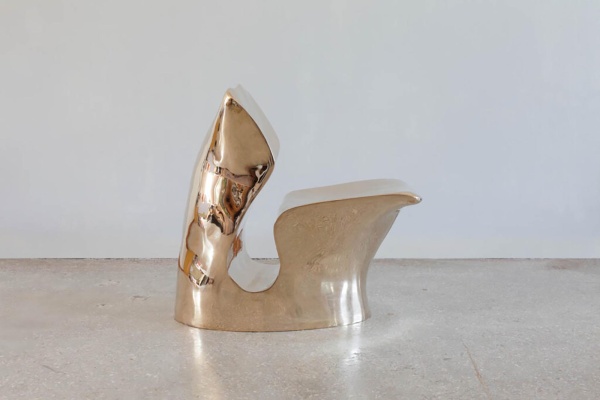
Don’t get swallowed by Volumetric Chair 7 by Voukenas Petrides. Courtesy of Gallery FUMI
Gallery FUMI brings us another bespoke piece of furniture, an enthralling golden chair from designer Voukenas Petrides. The bronze piece, manufactured in Greece, has a distinct hollow pit in the seat, which looks like it will swallow anyone who dares to take the glimmering throne. While Volumetric Chair 7 is certainly secure, it makes me wonder if Voukenas is trying to warn us about coveting luxurious objects—lust too much, and you may end up in the depths of hell. Produced in an edition of eight, it also has an asymmetrical, irregular form that signals its handmade rarity.
4. Golden Arc Console by Vikram Goyal
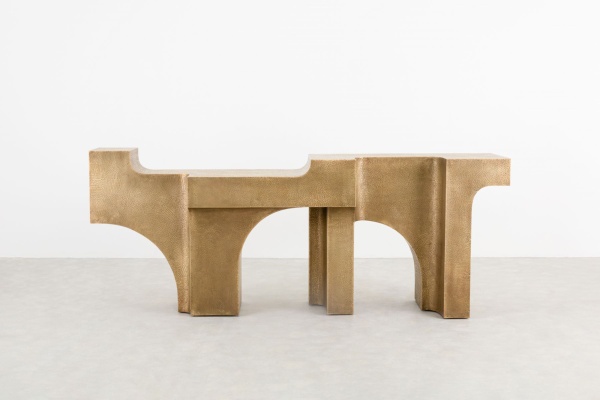
Golden Arc Console by Vikram Goyal has a beautiful hammered brass texture. Courtesy of Vikram Goyal and Nilufar
Nilufar Gallery introduced us to Vikram Goyal. With two entries on this list, Vikram cements himself as a designer to watch. The New Delhi-based designer works with local artisans to merge traditional craftsmanship with sculptural abstraction. The Golden Arc Console is part of a new collection of patinated bronze that bridges together arches and columns. This piece combines a bench, stool, and side table into one royal form. Up close, you can appreciate the console’s organic, spotted texture in the hammered bronze.
5. Low Table Pyrate by Vikram Goyal
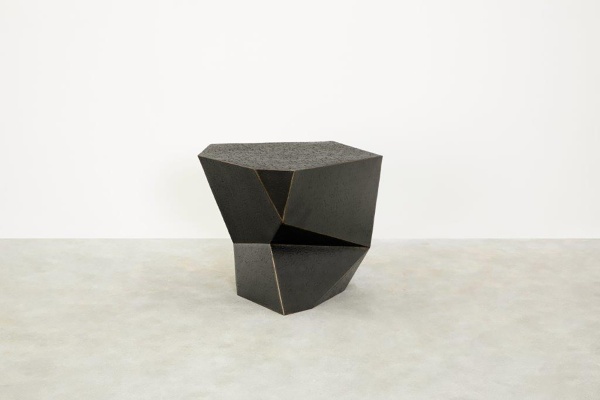
Vikram uses a technique he calls “hallowed joinery” to make his origami-like pieces. Courtesy of Vikram Goyal and Nilufar
Complement the Golden Arc Console with the squat Low Table Pyrate. It gets its origami shape from a process Vikram calls “hallowed joinery.” The novel technique welds hammered brass sheet metal, creating a light, hollow core. Vikram then removes the welding marks to make it look like sheets were gently folded like paper. Scrubbing away the marks leaves a shiny, copper outline along the creases, which catches the light and highlights the craftsmanship.
6. Clepsydra Table by Isin Sezai Avci
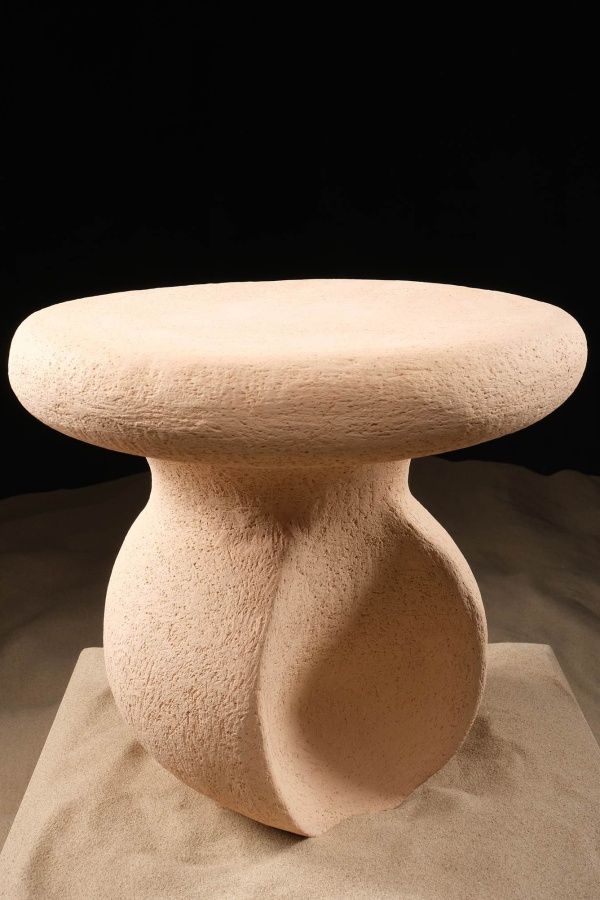
Clepsydra Table by Isin Sezai Avci was inspired by mushrooms and made from earthenware. Courtesy of 88 Gallery
Istanbul-based interior architect and designer Isin Sezgi Avci is fascinated by biomimicry and mycelia. Bulbous mushrooms become curvy, ceramic side tables, their button caps awaiting a cup of mellow chaga chai.
88 Gallery brings Isin’s Clepsydra Tables to PAD London. The hand-built structures are named after their hourglass forms, which are imbued with a feminine essence. In the right light the shadows hit an indentation Clepsydra’s base and form an alluring contrast; the table could be a cousin to the Venus of Willendorf.
7. Cocoon 2 by Mayumi Onagi
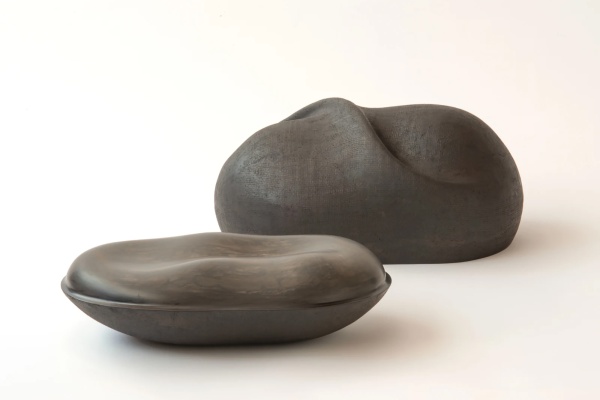
Mayumi Onagi mastered a process known as kanshitsu to naturally lacquer this vessel. Courtesy of Sarah Myerscough Gallery
Sarah Myerscough Gallery shows us interactive pieces by Mayumi Onagi, a Japanese artist who has mastered a process known as kanshitsu. This technique uses a natural lacquer called urushi to coat the surface of an object. The mixture is made with natural ingredients—mainly linen soaked in Urushi tree sap, with traces of soil, wood, and water. The lacquer needs to be applied slowly, layer by layer, drying fully between coats. On Mayumi’s pieces, the final output is a dark, matte finish that subtly shows the linen’s weave.
Mayumi’s Cocoon 2 is a decorative object that cracks open like a nut. A middle compartment hides that the piece is actually a vessel, perfect for stowing away beloved keepsakes. On a shelf, it will look like a sculptural object, the kanshitsu drapery hardened into a permanent shell.
8. Cinque Terre Side Table by Studio Sam London
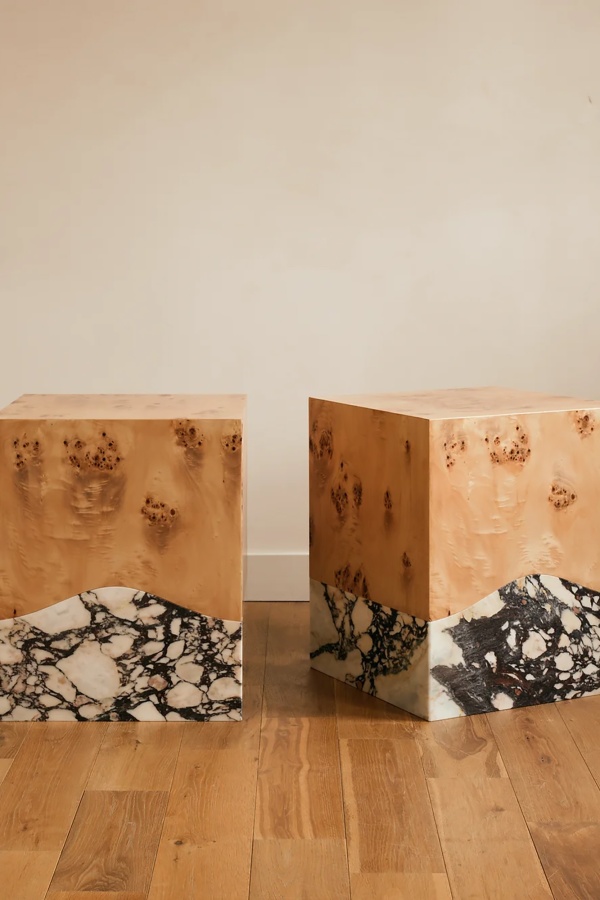
The Cinque Terre Side Tables by Studio Sam London illustrate the scent of the sea and wild herbs over the mountains. Courtesy of Melchiorri Studio Gallery
Alessandra Melchiorri, an Italian designer trained at London’s Central Saint Martins, considers Studio Sam an extension of the family business. She comes to PAD London not only as a designer, but as a part of Melchiorri Studio Gallery, a bespoke design gallery with showrooms in London and Milan.
Alessandra is showing her Cinque Terre side tables, which are inspired by the landscape in Liguria, Italy. She attempts to “reflect the scent of the sea and wild herbs over the mountains.” The tables’ marbled bases, speckled white and black, act as peaks and valleys cutting into a wooden sky. Made from wild burled timber, the tops of the tables are sanded into perfect cubes. The knots and notches floating through the grain drift along the surface like clusters of fragrances floating from water to sky.
9. B35 Tubular Steel & Leather Armchair by Marcel Breuer (c. 1928-29)
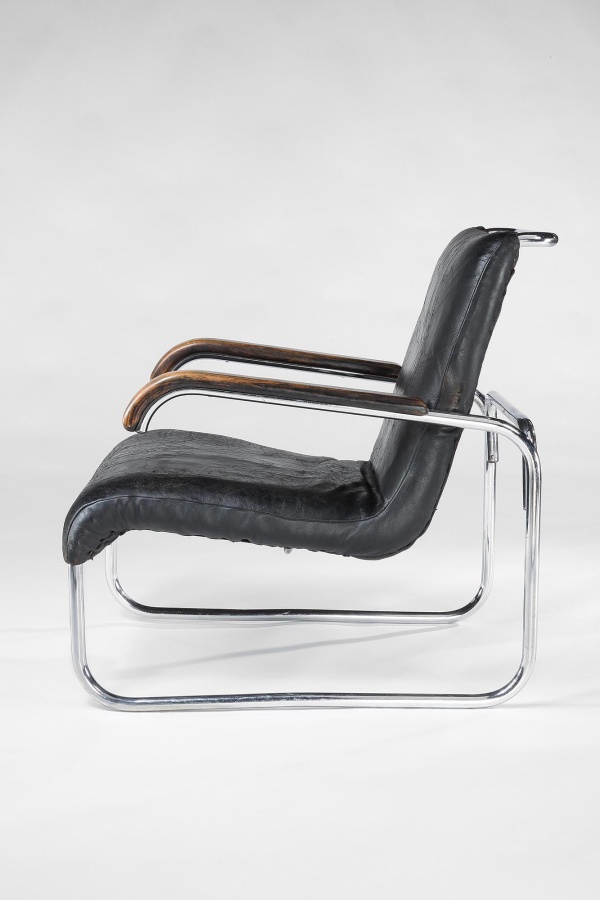
A rare find: the B35 Tubular Steel & Leather Armchair by Bauhaus-trained Marcel Breuer (c. 1928-29). Courtesy of Rose Uniacke
Though PAD London puts a lot of its focus on living designers, interior designer and gallerist Rose Uniacke brings vintage furniture to the fair to represent greats from the mid-century modern era. Among her collection is the B35 Tubular Steel & Leather Armchair by Marcel Breuer, manufactured by Thonet in the 1930s.
Marcel studied at the Bauhaus, and following the success of his iconic Wassily Chair (1925-26), created the B35 with similar materials. This chair, however, is more curvaceous than the boxy Wassily. The steel tubular cantilevered frame with beech armrests is swathed in its original black leather, but only in the places where the body makes contact. Otherwise, its shiny structure is shown off to the world.
10. Block Sculpture Console Table by Jean Yves Lanvin
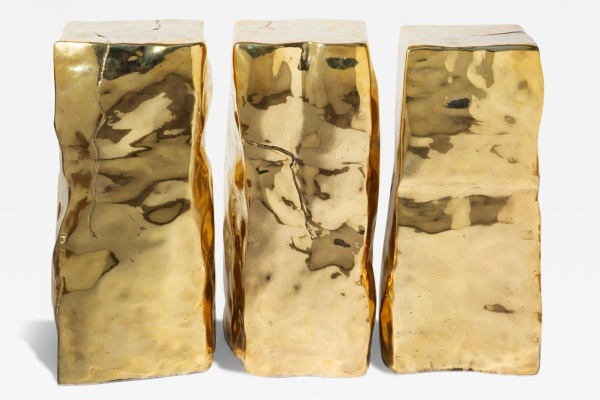
Spread the glitz around with Block Sculpture Console Table by Jean Yves Lanvin. Courtesy of Portuondo Gallery
Portuondo Gallery, co-owned by brothers Hugo and Diego Portuondo, has been around since 1969. I trust that they know a thing or two about collectible design, so I took notice of the work by Jean Yves Lanvin. He’s the great grandson of Jeanne Lanvin, founder of the Lanvin Haute Couture House, and grew up in the world of fashion. With such proximity to luxury, it’s not surprising that he would plate his Block Sculpture Console Table in a highly reflective polished brass. The table reflects pure opulence.
Jean’s free-floating side table is really just three individual pillars, inspired by raw marble slabs embedded into the mountains of Tuscany. They can huddle together to make one side table, or split apart to spread the glitz around.
11. Arctic Fox bench-sculpture by Abel Cárcamo
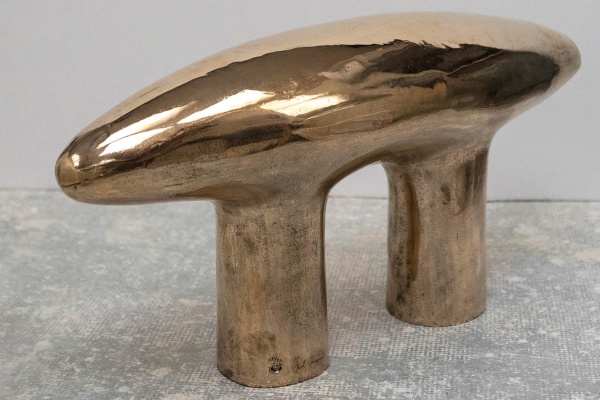
Abel Cárcamo’s bench evokes the arctic fox’s bushy tail. Courtesy of 88 Gallery
There’s a lot of golden hues floating around this year’s PAD London, but I can’t seem to get enough. Abel Cárcamo’s Arctic Fox bench-sculpture, made from cast bronze, is another shimmering piece that caught my eye. The plump form, sleek like a bullet, is like a bushy fox tail suspended on stout legs.
This isn’t Abel’s only work at PAD London. Gallery 88, who represents the Chilean artist, is also showing the Penzai Lamp, which Abel made in collaboration with another Gallery 88 artist, Emma Donnersberg. Of course, this amorphous piece is bronze.
12. Véga Coffee Table by Ado Chale (c.1980)
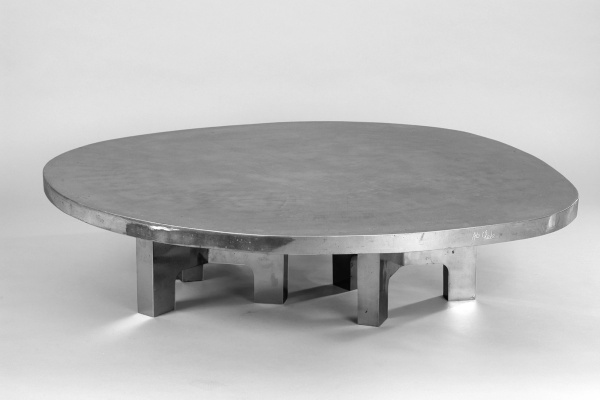
Ado Chale’s signature is unmistakable in polished aluminum. Courtesy of Galerie YV Gastou
Galerie YV Gastou, an antique and design dealer in Paris, brings us a cast aluminum table produced by Belgian industrial designer Ado Chale, the only one in existence. The Vega Coffee Table has an irregular, round top and a forest of stubby legs tucked underneath. The piece is relatively minimal for Ado, who is known for mosaic inlays, but the polished aluminum adds a subtle texture that adds nuance to the design. It also sports his signature. Ado’s name shines unmistakably along the edge of the table, making sure no one questions its creator.
13. Brutalista Coffee Table by Pietro Franceschini
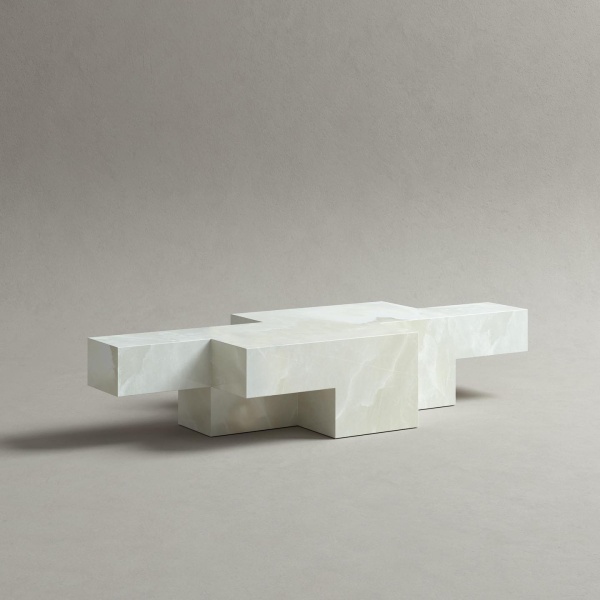
Pietro Franceschini swaps brutalism’s gray for an angelic white onyx. Courtesy of Galerie Philia
Three pieces presented by Galerie Philia wrap up our round up. The gallery’s mini exhibition, “Contrasts,” solidifies its impressive curatorial taste. We begin with Pietro Franceschini, an Italian designer who splits his time between Florence and New York City. With those two home bases, it’s no surprise his Brutalista coffee table channels the blocky, concrete architecture of the mid-century movement. However, Pietro swaps slate gray tones for an angelic white onyx. With no inlays or visible seams, it feels like it has been carved from a single block of stone.
14. Fabric Flexible Light by Morghen Studio
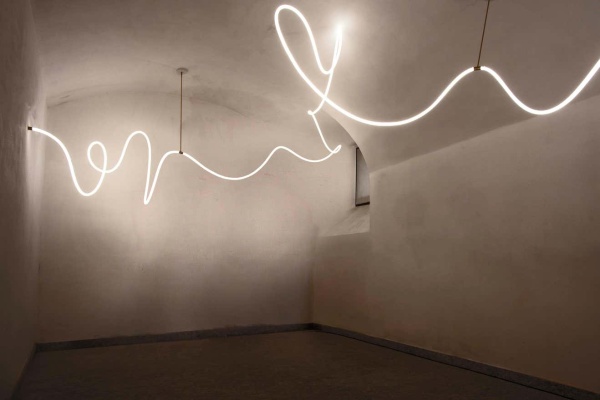
Ink appears to freeze mid-air with Fabric Flexible Light by Morghen Studio. Courtesy of Galerie Philia
Fabric lights seem to be all the rage right now—take Marcel Wander’s spiritual Skynest, a structured iteration of the material, for example. Roberto Tarter and Rodolfo Viola of Morghen Studio elaborate upon the topology by letting the coils of fabric light flow freely. The light curls, twists, and loops, as if someone held a pen to the sky, doodled absentmindedly, and the ink froze into a dreamy glow. One advantage of the Fabric Flexible Light is that it can be customized for any space. The light can somersault through long corridors, or it can spin a web in a corner.
15. Monolithic Chair 1 by Studiopepe
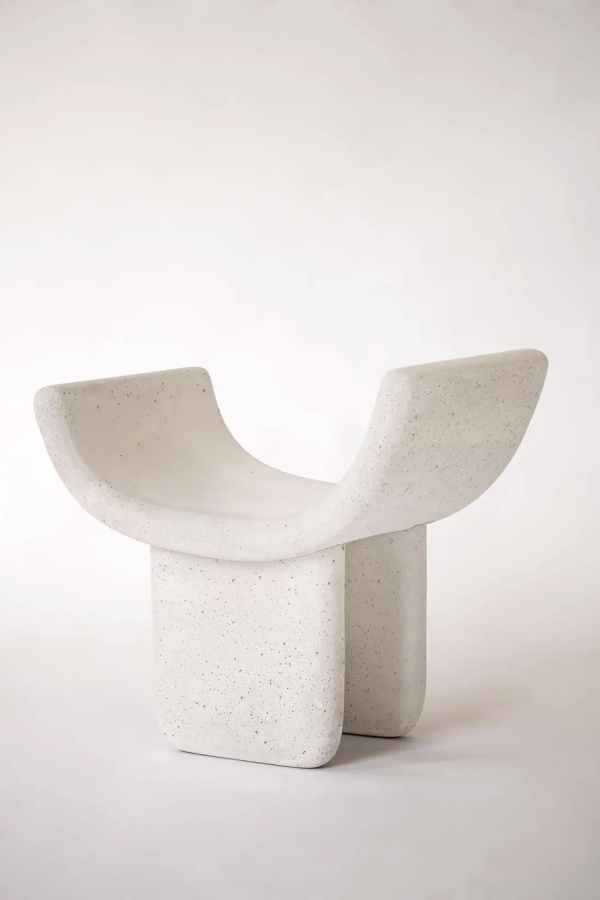
Monolithic Chair 1 by Studiopepe makes concrete look lighter than air. Courtesy of Galerie Philia
Studiopepe is a design and architecture creative studio from Milan. Founders Arianna Lelli Mami and Chiara Di Pinto, who have backgrounds in interior design and industrial design, respectively, are attracted to rough materials like concrete, but they find ways to make it look light and airy. Monolithic Chair 1 balances a deep arc on two beveled slabs, like feet on tiptoes. Somehow, it works. The form reminds me a bit of a Lego hand, but honestly, who hasn’t wanted to be cradled in those deep grooves? Instead of a bright yellow, Studiopepe opts for elegant white.
